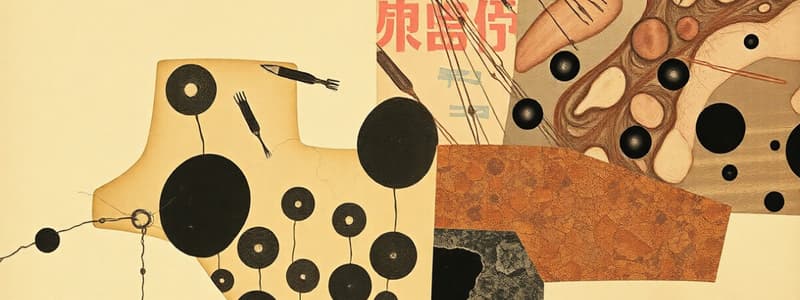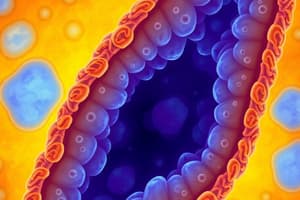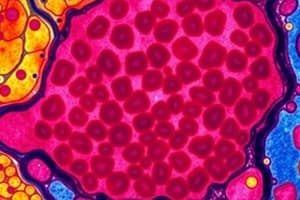Podcast
Questions and Answers
What is the primary function of simple columnar epithelium?
What is the primary function of simple columnar epithelium?
- Secretion and absorption (correct)
- Filtration
- Protection
- Transport of gases
Where is stratified squamous epithelium primarily located?
Where is stratified squamous epithelium primarily located?
- Kidney tubules
- Glands and ducts
- Skin and mouth (correct)
- Lining of the respiratory tract
What distinguishes pseudostratified epithelium from true stratified epithelium?
What distinguishes pseudostratified epithelium from true stratified epithelium?
- Its cells do not reach the basement membrane.
- It consists of multiple cell layers.
- All cells reach the basement membrane. (correct)
- Cells are flattened at the top.
Which structural feature enhances the absorption area in simple columnar epithelium?
Which structural feature enhances the absorption area in simple columnar epithelium?
What type of epithelium is uniquely adapted to stretch and is found in the urinary bladder?
What type of epithelium is uniquely adapted to stretch and is found in the urinary bladder?
What is the main distinction between endocrine and exocrine glands?
What is the main distinction between endocrine and exocrine glands?
What characteristic do goblet cells possess in columnar epithelium?
What characteristic do goblet cells possess in columnar epithelium?
Which type of epithelium is often involved in filtration processes, particularly in kidneys?
Which type of epithelium is often involved in filtration processes, particularly in kidneys?
What is a key feature of stratified cuboidal epithelium?
What is a key feature of stratified cuboidal epithelium?
Which type of epithelial tissue forms a barrier that helps prevent water loss in the skin?
Which type of epithelial tissue forms a barrier that helps prevent water loss in the skin?
What is the main function of epithelial tissue?
What is the main function of epithelial tissue?
Which characteristic is NOT associated with epithelial tissue?
Which characteristic is NOT associated with epithelial tissue?
What type of epithelium is composed of a single layer of flattened cells?
What type of epithelium is composed of a single layer of flattened cells?
What feature is found on the underside of epithelial cells that anchors them?
What feature is found on the underside of epithelial cells that anchors them?
Which type of epithelial tissue is best suited for absorption?
Which type of epithelial tissue is best suited for absorption?
Which of the following describes the shape of cuboidal epithelial cells?
Which of the following describes the shape of cuboidal epithelial cells?
What process is primarily carried out by the epithelial cells in the kidney tubules?
What process is primarily carried out by the epithelial cells in the kidney tubules?
How many layers of cells characterize stratified epithelial tissue?
How many layers of cells characterize stratified epithelial tissue?
What type of epithelial tissue would likely be found lining the surfaces of organs exposed to friction?
What type of epithelial tissue would likely be found lining the surfaces of organs exposed to friction?
Which type of epithelial tissue is specialized for secretion?
Which type of epithelial tissue is specialized for secretion?
Flashcards
Epithelial Tissue
Epithelial Tissue
Groups of similar cells that cover and line body surfaces and form glands.
Epithelial Tissue Function
Epithelial Tissue Function
Protection, absorption, filtration, and secretion. It protects, absorbs, filters, and secretes.
Simple Squamous Epithelium
Simple Squamous Epithelium
A single layer of flattened cells that facilitates absorption and filtration.
Basement Membrane
Basement Membrane
Signup and view all the flashcards
Avascularity
Avascularity
Signup and view all the flashcards
Squamous Cells
Squamous Cells
Signup and view all the flashcards
Cuboidal Cells
Cuboidal Cells
Signup and view all the flashcards
Columnar Cells
Columnar Cells
Signup and view all the flashcards
Simple Epithelium
Simple Epithelium
Signup and view all the flashcards
Stratified Epithelium
Stratified Epithelium
Signup and view all the flashcards
Simple Cuboidal Epithelium Structure
Simple Cuboidal Epithelium Structure
Signup and view all the flashcards
Simple Cuboidal Epithelium Function
Simple Cuboidal Epithelium Function
Signup and view all the flashcards
Simple Columnar Epithelium Structure
Simple Columnar Epithelium Structure
Signup and view all the flashcards
Simple Columnar Epithelium Function
Simple Columnar Epithelium Function
Signup and view all the flashcards
Pseudostratified Epithelium Structure
Pseudostratified Epithelium Structure
Signup and view all the flashcards
Pseudostratified Epithelium Location
Pseudostratified Epithelium Location
Signup and view all the flashcards
Stratified Squamous Epithelium Structure
Stratified Squamous Epithelium Structure
Signup and view all the flashcards
Stratified Squamous Epithelium Function
Stratified Squamous Epithelium Function
Signup and view all the flashcards
Transitional Epithelium Function
Transitional Epithelium Function
Signup and view all the flashcards
Gland Types
Gland Types
Signup and view all the flashcards
Study Notes
Tissue Introduction & Epithelial Tissue
- Tissues are groups of cells with similar structure and function
- Human bodies develop from single to multicellular cells. Cells specialize.
- The body is an interdependent system. Malfunction of one cell group can be catastrophic
Cells to Tissues
- Specialized cells form tissues.
- Tissues then combine to form organs.
Types of Tissues
- Epithelium: Coverings and linings of surfaces (e.g., skin)
- Connective: Support (e.g., bone, ligaments, fat)
- Muscle: Movement
- Nervous: Control (e.g., brain, nerves, spinal cord)
Function of Epithelial Tissue
- Protection: Skin protects from sunlight, bacteria, and physical damage.
- Absorption: Lining of the small intestine absorbs nutrients into the blood.
- Filtration: Lining of the kidney tubules filters wastes from blood plasma.
- Secretion: Glands produce perspiration, oils, digestive enzymes, and mucus.
Characteristics of Epithelial Tissue
- Continuous sheets (like tiles)
- Apical surface: Top surface of cells, borders an open space (lumen).
- Basement membrane: Underside of epithelial cells, anchors to connective tissue.
- Avascular: Lacks blood vessels.
- Nourished by connective tissue.
- Regenerate and repair quickly.
Classification of Epithelial Tissue
- Cell Shape:
- Squamous: Flattened, like fish scales
- Cuboidal: Cube-shaped
- Columnar: Column-shaped
- Cell Layers:
- Simple: One layer of cells
- Stratified: Many layers of cells
- Named for the cell type at the apical surface
Simple Squamous Epithelium
- Structure: Single layer of flattened cells
- Function: Absorption and filtration
- Not effective protection due to single layer.
- Location: Walls of capillaries, air sacs in lungs, serous membranes in body cavities
Simple Cuboidal Epithelium
- Structure: Single layer of cube-shaped cells
- Function: Secretion and transportation in glands, filtration in kidneys
- Location: Glands and ducts (pancreas, salivary), kidney tubules, covers ovaries.
Simple Columnar Epithelium
- Structure: Elongated layer of cells with nuclei at the same level.
- Function: Absorption, protection, secretion. When open to body cavities called mucous membranes.
- Special features: Microvilli (increase surface area and absorption), goblet cells (protective mucus)
- Location: Linings of the entire digestive tract
Pseudostratified Epithelium
- Structure: Irregularly shaped cells with nuclei at different levels, appear stratified, but all cells reach basement membrane
- Function: Absorption and secretion, goblet cells (produce mucus), Cilia (sweep mucus)
- Location: Respiratory linings and reproductive tract
Stratified Squamous Epithelium
- Structure: Many layers, usually cuboidal/columnar at the bottom and squamous at the top
- Function: Protection, keratin (protein) waterproofs and toughens the skin
- Location: Skin (keratinized), mouth, and throat
Transitional Epithelium
- Structure: Many layers, cells at the base are cuboidal or columnar, cells at the surface vary, Change between stratified and simple as tissue is stretched out.
- Function: Allows stretching (changes size).
- Location: Urinary bladder, ureters, and urethra
Glands
- One or more cells that make and secrete a product
- Secretion: Protein in an aqueous solution (hormones, acids, oils)
- Endocrine glands: No duct, release secretion into blood vessels (often hormones), e.g., thyroid, adrenal, pituitary
- Exocrine glands: Contain ducts, empty onto epithelial surfaces; e.g., sweat, oil, salivary, mammary glands
Shapes of Exocrine Glands
- Branching: Simple (single, unbranched duct) or Compound (branched)
- Shape: Tubular (shaped like a tube) or Alveolar (shaped like flasks or sacs). Tubuloalveolar (has both tubes and sacs)
Modes of Secretion
- Merocrine: Released by exocytosis without altering the gland (e.g., sweat and salivary glands).
- Holocrine: Gland ruptures and releases secretion and dead cells (sebaceous glands).
Studying That Suits You
Use AI to generate personalized quizzes and flashcards to suit your learning preferences.
Related Documents
Description
Explore the fundamental aspects of tissues and the vital role of epithelial tissue in the human body. This quiz covers the types of tissues, their functions, and the specific characteristics of epithelial tissue. Understand how specialized cells work together to form organs and systems in a multicellular organism.



